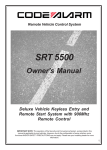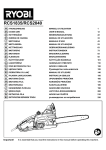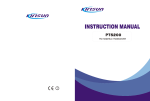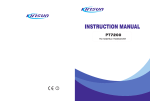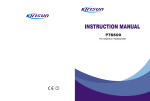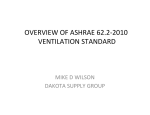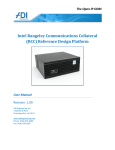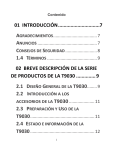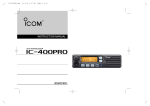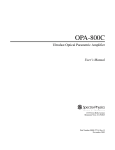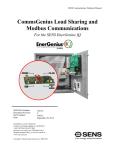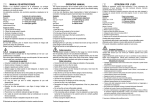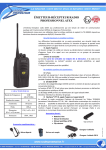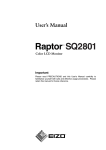Download R&S CMS Radiocommunication Service Monitor
Transcript
Version 05.00 ¸CMS Radiocommunication Service Monitor Radio testers for service, production, and development ◆ Frequency range from 0.4 MHz to 1000 MHz ◆ Radio tester family incending two models to cover all measurement requirements ◆ Suitable for every type of radio equipment ◆ Transmitter, receiver, and duplex measurements on mobile radios, base stations, and RF modules ◆ Analog signaling ◆ Simultaneous display of settings and results ◆ Manual and automatic measurements ◆ Tracking generator ◆ Spectrum monitor ◆ Stationary and mobile use ◆ Cable fault finder October 2007 Two radio tester models to suit every application ¸CMS57 The specialist for avionics ◆ Transmitter and receiver testing ◆ RF spectrum monitor with zero-span to full-span display ◆ Extremely sensitive RF frequency counter ◆ Transient recorder for – frequency versus time – power versus time ◆ Fully automatic testing Additional equipment ◆ VOR/ILS signal generator Versatile fields of application ... The ¸CMS radiocommunication service monitor is the ideal radio tester for use in service, maintenance, and test departments. It is suitable for all transceivers using AM, FM or, jM as well as SSB. Optional extensions enable the ¸CMS to satisfy all requirements of radio measurements and even to cover related fields. Low weight, compact size, and low power consumption make this instrument particularly suitable for mobile use. Whether stationary or mobile, the ¸CMS with its extensive test facilities always provides a valuable service. The ¸CMS uses a high-contrast, backlit LCD screen with high resolution and is operated via softkeys. A clear menu structure allows fast and direct access to all measurement facilities. With the autorun control and printer interface, automatic test routines can easily be configured and stored via the front-panel keypad. Tolerances can be inserted into these test routines to determine and log pass/fail limits. ¸CMS Radiocommunication Service Monitor Battery-backed memory cards are used as program and test report library. Test reports, program lists, and screen hardcopies can be output on a printer. ¸CMS54 The high-end tester for demanding requirements ◆ Transmitter and receiver testing ◆ RF spectrum monitor with zero-span to full-span display ◆ Extremely sensitive RF frequency counter ◆ Transient recorder for – frequency versus time – power versus time ◆ Fully automatic testing Additional equipment ◆ Full-span tracking generator from 0.4 MHz to 1000 MHz ◆ Adjacent-channel power meter with standard ETSI filters ◆ Duplex modulation meter ◆ Automatic harmonic measurements ◆ Cable fault finder ... in service Ease of operation, automatic presettings and test routines, as well as clear display of all parameters ensure efficient measurements. ... in production The ¸CMS can be used in production environments both for module testing and for final system testing without any restriction. The built-in autorun control allows modules to be tested and adjusted without the need for an external controller, the results being logged at the same time. The ¸CMS can also be integrated into larger test systems via the IEC/IEEE bus, which results in short measurement times in pre- and final testing. ... on-site The ¸CMS is a rugged and handy unit that is particularly suitable for mobile use. It can be supplied from the local DC voltage (long operating times due to low power consumption). The results of the automatic transceiver test can be stored on a memory card for later analysis and printout. ... in development The ¸CMS offers great benefits to the development engineer: In a minimum of space it combines RF and AF generators as well as analyzers with high accuracy and wide dynamic range. The ¸CMS54 in particular features measurement capabilities, such as measurement of frequency/power transients of mobile phones, base stations or RF modules, which usually require a comprehensive set of measuring instruments. ¸CMS A test set replacing many individual measuring instruments Due to the comprehensive standard configuration of the individual ¸CMS models and the optional extensions tailored to specific applications, additional external measuring instruments are not required. Signal sources ◆ RF synthesizer from 0.4 MHz to 1000 MHz, resolution 10 Hz, with AM, FM, jM, and multitone modulation capabilities ◆ Two independent modulation generators, 20 Hz to 30 kHz each, resolution 0.1 Hz ◆ Selective-call coder for all standards (also user-programmable) ◆ CDCSS coder ◆ DTMF coder ◆ 10 MHz reference frequency input/output ◆ VOR/ILS signal generator Measuring facilities ◆ RF frequency counter, RF frequencyoffset counter ◆ RF power meter from 1 mW to 100 W ◆ Selective RF power meter down to –100 dBm ◆ RF spectrum monitor with wide dynamic range and filters that also allow modulation analysis (AM, FM, SSB) ◆ Tracking generator in frequency range from 400 kHz to 1000 MHz ◆ Adjacent-channel power meter with standard ETSI filters ◆ Modulation meter for AM, FM, and jM; detectors: +PK, –PK, PK HOLD, ±PK/2, RMS, RMS √2 ◆ Duplex modulation meter for duplex spacings of any size ◆ AF voltmeter with peak and true RMS weighting ◆ SINAD meter with variable test frequency ◆ S/N meter ◆ Distortion meter with variable test frequency ◆ AF frequency counter with period and gate-time counting ◆ Selective-call decoder for all standards (also user-programmable) ◆ DTMF decoder ◆ Oscilloscope ◆ DC ammeter/voltmeter ◆ Transient recorder for analysis of power and frequency transients ◆ SSB menus ◆ Harmonic measurements ◆ Cable fault finder Filters ◆ CCITT or C-message filter for weighting in line with relevant standards ◆ Continuously tunable bandpass filter from 50 Hz to 5 kHz with high skirt selectivity for selective modulation and AF measurements ◆ Continuously tunable notch filter from 100 Hz to 5 kHz for signal suppression ◆ Highpass and lowpass filters for band limiting and measurement of subaudio tones Other facilities ◆ Second RF input with high sensitivity for off-air measurements, can be used independently for module testing ◆ Connector for battery ◆ 13 dBm RF output for off-air measurements ◆ Memory for storing complete instrument setups ◆ Carrying bag Automatic tests Automatic test routines are indispensable for high throughput and reproducible results in service and production: In the learn mode, the ¸CMS radiocommunication service monitor stores all manual settings and measurements and produces from them ready-to-start automatic test routines. The user does not require any programming knowledge or have to learn equipment-specific command sets. Tolerances, comments, and conditions (loops, jumps, queries, and control commands) can additionally be inserted into these test routines. Programs can also be activated directly from the memory card. The test report format may be userspecified and can be clearly structured by transferring control characters to the printer, such as blank line, paragraph, and boldface. ¸CMS Radiocommunication Service Monitor ¸CMS user prompting ... The user interface, which shows all important measurements and allows entry of the necessary parameters, is optimized for each application. Erroneous settings immediately result in a prompt for clarification from the user. Submenus can be called up for setting or evaluating specific parameters. Transmitter test: RF measurements, evaluation of demodulated signals, and setting of modulation generators Contents, duration, and frequency deviation of selective call signals Zoom function for alignment Using the insertion units of the ¸NAS family, VSWR, forward and reflected power can be indicated Settings made are shown in the main menu so that erroneous measurements due to unknown background settings are impossible. The user interface may be selected in English, French, German, Italian, Spanish, or Swedish. Instrument settings and frequencies can be saved in an internal nonvolatile memory and recalled as required. Spectrum monitor/tracking generator: 150 Hz filter allowing direct modulation analysis for AM, FM, and SSB ¸CMS Radiocommunication Service Monitor ... all settings and test parameters at a glance Channel numbers and duplex spacing can be defined and used instead of frequencies Receiver test: generator settings, evaluation of receiver AF, and carrier modulation setting External modulation can be used, e.g. for modulating several tones or data signals for various systems Duplex test: transmitter and receiver parameters at a glance; efficient measurements on duplex radio equipment and modules Semi-automatic search routines for squelch level, receiver bandwidth, and sensitivity perform elaborate measurements within a few seconds Signaling The ¸CMS features built-in signaling units combining signaling measurements and receiver/transmitter tests on mobile stations as well as, to a certain extent, on base stations. No external equipment is required for testing. All signaling routines are permanently available (no loading or reloading of software is required). The following standards can be simulated: ◆ Selective call in line with all international standards ◆ DTMF coding and decoding The signaling units support all main radio networks including their countryspecific versions. ◆ CDCSS (continuous digital coded squelch system) ¸CMS Radiocommunication Service Monitor ¸CMS54 – the radio tester for the high-end service For all fields of radiocommunications ◆ Base-station testing and monitoring ◆ Development of RF modules for any application such as – radio remote control – cordless telephones – door-closing systems ◆ Production and installation of systems with high or low transmitter power, such as – high-power transmitters – radio telephones, mobile phones ◆ Duplex modulation meter with any frequency offset ◆ Direct measurement of transmitter harmonic suppression Full-span spectrum monitor ◆ Full-span spectrum display from 10 MHz to 1000 MHz ◆ Display range 80 dB ◆ Analysis bandwidths from 150 Hz (modulation spectra AM/FM/SSB) to 3 MHz ◆ Sensitivity down to –110 dBm ◆ Markers for synthesizer-accurate frequency measurements and selective level measurements ◆ Reference marker ◆ Storage of spectrum displays and demodulation of displayed spectral lines (FREEZE & LISTEN) ◆ Quick mode for fast alignment of RF components ◆ Built-in tracking generator with selectable level and frequency offset; for measurements on filters, modules, and antenna systems ◆ Cable fault finder Transient frequency and power measurements Display of frequency transients when switching transceivers on/off or when changing channel ¸CMS Radiocommunication Service Monitor Combined display of power and frequency transients Measurement of power levels upon switching a transmitter on and off or of power ramps (data transmission system) Adjacent-channel power measurement Adjacent-channel power can be measured directly without external filters. The filters required in line with ETSI recommendations are integrated in the ¸CMS. Harmonic measurements Harmonics in the range up to 1 GHz are measured at a keystroke and displayed in digital and analog form. Transient recorder (also for the ¸CMS57) Measurement of power and frequency as a function of time with graphical display and selectable zoom Time scale 50 µs/div to 1 s/div, max. recording time 40 s Frequency transients RF measurement range 1 MHz to 1000 MHz FM deviation measurement range 0 kHz to ±100 kHz Scaling 0.5 kHz to 50 kHz/div Triggering internal, automatic (frequency changes >8 kHz) Power transients Additional data of the¸CMS54 Specifications of Base Unit (pages 13 and 14) are fully applicable. RF measurement range 1 MHz to 1000 MHz Display dynamic range 60 dB (for 47 dBm at input 1) Scaling 2/5/10/20 dB/div Triggering internal, automatic (power 10 %) Adjacent-channel power measurements (with the ¸CMS-B9 also for the ¸CMS57) Filter ETSI recommendation RF spectrum monitor (also for ¸CMS57) Frequency range 1 MHz to 1000 MHz Span 0 Hz (zero span) to 50 MHz; full span for frequency range 10 MHz to 1000 MHz Reference level +47 dB to –47 dBm (input 1) Sensitivity <–110 dBm (for resolution filter ≤6 kHz and reference level ≤–37 dBm at input 2, f ≥ 10 MHz) Display dynamic range >65 dB (for reference level >–7 dBm at input 1) Scaling 2/5/10 dB/div Display range ≤80 dB Resolution filter (3 dB bandwidth) 150 Hz (for modulation analysis), 6/16/50/300 kHz/1/3 MHz (for full span), coupled to span Error <3 dB + resolution Resolution 0.4 dB Channel spacings 10/12.5/20/25 kHz and user selectable up to 1 MHz Frequency transients Dynamic range (CW, FM) 1 MHz to 1000 MHz 70 dB 69 dB 68 dB 66 dB 25 kHz 20 kHz 12.5 kHz 10 kHz Harmonic measurements (with the ¸CMS-B9 also for the ¸CMS57) Display of 1st to 4th harmonic Max. harmonic frequency 1000 MHz Dynamic range >60 dB >90 dB in frequency range 26.965 MHz to 27.405 MHz (CB radio) RF frequency counter (also for the ¸CMS57) Tracking generator (with ¸CMS-B9 also for the ¸CMS57) Frequency range 400 kHz to 1000 MHz Reference level –27 dBm to –67 dBm Display dynamic range 50 dB (1 MHz to 500 MHz) 45 dB (500 MHz to 1000 MHz) Span 0 (zero span) to full span Filters (3-dB bandwidth) 150 Hz, 6/16/50/300 kHz, 1/3 MHz (coupled to span) Error <3 dB (relative measurement <0.5 dB) Resolution 0.4 dB Output level 0 dBm to –128 dBm Frequency offset 0 Hz to ±999 MHz (depending on span and center frequency) Frequency range 0.5 MHz to 1000 MHz (usable from 100 kHz, IF narrow) Input level range (CW, FM) Input 1 Input 2 0 dBm to +47 dBm –40 dBm to +7 dBm Transmitter measurement, 2nd RF input (also for the ¸CMS57) Additional internal, switch-selectable 0/24 dB attenuator pad for measurements with higher levels at input 2 ¸CMS Radiocommunication Service Monitor Unit in original size ◆ All functions are clearly displayed; 16 softkeys allow direct access to individual parameters ¸CMS Radiocommunication Service Monitor ◆ The large, backlit LCD screen provides clear and simultaneous readout of all test results, entries, and functions ◆ Hardcopy of screen display, entry of tolerance and reference values are made at a keystroke ◆ Settings can be varied in selectable steps using the rotary knob ◆ Programs, instrument settings, and test results can be stored on memory cards ◆ Additional inputs and outputs allow independent and versatile use of signal sources and test facilities ¸CMS Radiocommunication Service Monitor ¸CMS57 – the avionics specialist The ¸CMS57 radiocommunication service monitor is the ideal radio tester for service and maintenance in the field of avionics. A built-in VOR/ILS signal generator generates all test signals for ◆ ◆ ◆ ◆ VOR (VHF omnidirectional range) ILS (instrument landing system) MB (marker beacon) Autopilot Frequencies and deviations adjustable over a wide range allow receiver testing in line with standards The VOR/ILS test signals are available as RF and AF signals at different outputs. The RF is not limited to the defined receiving ranges, but can be user-selected for versatile applications (e.g. IF module testing). Since the VOR/ILS AF signal is provided separately, it can be fed into demodulators, filters, or rectifiers of the receiver or be used as the modulation source of a second signal generator for use as a jammer in the adjacent channels. The ¸CMS57 combines conventional radiocommunication and radionavigation measurement facilities so that avionics measurements can be performed by a single instrument. Typical features such as selectivity and sensitivity of the VOR/ ILS receiver can be checked. A second, switchable RF input plus the selective RF level meter and spectrum monitor meet all requirements even for measurements on frequency-converting modules. Parallel utilization of all capabilities offered results in additional advantages for VOR/ILS applications. The AF voltmeter and the oscilloscope are, for instance, simultaneously available for AF measurements. 10 ¸CMS Radiocommunication Service Monitor Fine variation of the DDM value in steps of 0.001 DDM for ILS and of phase in steps of 0.01° for VOR ensure accurate adjustment of onboard monitor The AF oscilloscope can be used in all operating modes, allowing, for instance, simultaneous display of the signal demodulated by the device under test A menu is also available for the generation of marker beacons Specific data of the ¸CMS57 VOR/ILS generator (specifications of base unit, pages 13 and 14, are fully applicable.) The operating concept of the ¸CMS57 is designed in such a way that only a few settings are required for testing all characteristics of VOR/ILS receivers. Signal parameters are defined either by ◆ direct keyboard entry ◆ fine variation via rotary knob or Phase RF output Phase AF output 9960 Hz carrier Modulation frequency Amplitude modulation –128 dBm to –9 dBm – 85 dBm to –45 dBm FM deviation 30 Hz VAR Modulation frequency Amplitude modulation –128 dBm to –9 dBm – 85 dBm to –45 dBm ◆ recall of preset standard RF frequencies ◆ fixed coupling of ILS glideslope and ILS localizer frequencies in line with the specification ◆ recall of preset test parameters such as phase or DDM (difference in depth of modulation) 1020 Hz AUX Modulation frequency Amplitude modulation By varying all test parameters an in-depth analysis of all functions is possible. In addition, a fast functional test may be carried out by simply recalling the standard settings in line with ARINC 578, 579. Small size, low weight, and battery operation enable the ¸CMS57 to be used in the cockpit or outside the aircraft for fast go/nogo testing based on off-air measurements (RAMP test). Range Resolution Error 0 ° to 360 ° 0 ° to 360 ° 0.01 ° 0.01 ° typ. 0.05 ° ≤0.04 ° 0.1 % AM 0.1 % AM 1 Hz typ. <2 % for 30 % AM <2 % for 30 % AM ≤1 Hz 0 % to 100 % 0 % to 100 % 0.1 % AM 0.1 % AM typ. <2 % for 30 % AM <2 % for 30 % AM 50 Hz to 20 kHz 0 % to 100 % 0.1 % AM ≤3 %, for 1020 Hz and 10 % to 20 % AM VOR 7.9 kHz to 12 kHz 0 % to 100 % 0 % to 100 % 384 Hz to 576 Hz 24 Hz to 36 Hz ILS ≤1 ° 90 Hz and 150 Hz phase 0 ° to180 °, referred to 150 Hz 0.01° 90 Hz tone Modulation frequency 72 Hz to 108 Hz 150 Hz tone Modulation frequency 120 Hz to 180 Hz 1020 Hz tone (AUX) Modulation frequency Amplitude modulation 50 Hz to 20 kHz 0 % to 100 % 0.1 % AM ≤3 %, for 1020 Hz and 10 % to 20 % AM 0 % to 50 % 0 % to 50 % 0.1 % AM 0.1 % AM typ. <2 % for 20 % AM <2 % for 20 % AM ILS localizer Amplitude modulation –128 dBm to –9 dBm – 85 dBm to –45 dBm DDM1) RF output ±0 to 0.4 DDM for 20 % AM On-course error, –128 dBm to –9 dBm Off-course error, –128 dBm to –9 dBm 0.001 DDM DDM AF output ±0 to 0.4 DDM for 20 % AM 0.001 DDM ≤3 % + 0.0002 DDM for |DDM| ≤0.4, AF level 0.5 V to 5 V 0 % to 50 % 0 % to 50 % 0.1 % AM 0.1 % AM <0.0004 DDM <2 % + 0.0004 DDM for |DDM| ≤0.2 ILS glidescope Amplitude modulation –128 dBm to –9 dBm – 85 dBm to –45 dBm typ. <2 % for 40 % AM <2 % for 40 % AM DDM RF output ±0 to 0.8 DDM for 40 % AM On-course error, –128 dBm to –9 dBm Off-course error, –128 dBm to –9 dBm 0.001 DDM DDM AF output 0.001 DDM ≤3 % + 0.002 DDM for |DDM| ≤0.4, AF level 0.5 V to 5 V ±0 to 0.8 DDM for 40 % AM <0.001 DDM <2 % + 0.001 DDM for |DDM| ≤0.4 Marker beacon (MB) Difference in Depth of Modulation; describes the 1) modulation depth difference between the 90 Hz and the 150 Hz tone; |DDM| = |(90 Hz modulation in % - 150 Hz modulation in %)|/100 %. Modulation frequency 400 / 1300 / 3000 Hz Amplitude modulation 0 % to 100 % 0.1 % AM ≤5 % for 95 % AM 1020 Hz tone (AUX) Modulation frequency Amplitude modulation 50 Hz to 20 kHz 0 % to 100 % 0.1 % AM same as base unit ¸CMS Radiocommunication Service Monitor 11 Options and their applications Extensions for base unit Option Order No. Specifications OCXO Reference Oscillator For long-term stability ¸CMS-B1 0840.9406.02 see time base Aging2 × 10–7/year OCXO Reference Oscillator For extremely high long-term stability ¸CMS-B2 1001.6809.02 Specs same as ¸CMS-B1, except for aging ≤1× 10–7/year 0840.9506.021) For specs see base unit, specs for ACP meter and harmonic measurements on page 7 ¸CMS-B9 Duplex Modulation Meter Allows operation of RF frequenzy counter and modulation meter independent of RF signal generator (twopart measurements, also on frequency-converting modules); provides tracking generator, cable fault finder, adjacent-channel power meter, harmonic measurements TTL levels, Zout ≈ 50 W, f = 10 MHz level >1.5 V (Vpp), Zin ≈ 50 W, f = 10 MHz ±500 Hz 10 MHz Reference Frequency Input/Output External synchronization for measuring systems ¸CMS-B22 1001.6750.02 Output Input Additional RF Input/Output Two-signal measurements and connection of further measuring instruments ¸CMS-B31 1001.7005.02 Maximum input power20 mW Attenuation betw. RFin and RFout32 dB Measurement sensivity at input 1 for RF counter/transient recorder and demodulation reduced by 6 dB 100 W RF Power Meter Measurement of high RF input power ¸CMS-B32 1001.7905.02 Max. input power: 100 W for 3 min, then 10 min power off Continuous power: 80 W, max. output level and measurement sensitivity at input 1 reduced by 3 dB; additional error ≤0.2 dB (P >40 mW, AM = 0 %) 13 dBm Output ¸CMS-B34 1032.1350.02 Additional power output for off-air measurements Protection for Input 2 ¸CMS-B60 1075.5006.02 BNC connector with exchangeable fuse ¸CMS-B5 0841.0502.10 ¸CMS-B55 1032.0790.02 Specifications Optional control interfaces2) Order No. DTMF Decoder • • CCITT Filter • • Centronics Interface • • Direct printer connection Relays 8 — Switching relays with max. 1 W switching power, Vmax = 30 V, Imax = 0.1 A TTL Input/Output 12 — Outputs: 25 mA driver power Decoding of DTMF dual tones and VDEW direct dialing Extensions in conjunction with control interfaces Option Order No. Specifications ATIS Coder/Decoder For ¸CMS-B5 ¸CMS-B27 1032.1250.02 CDSS Decoder For ¸CMS-B5 ¸CMS-B27 with ¸CMS-B33 Coder – entry of 10-digit ATIS code – sending of ATIS message Decoder – decoding and display of 10-digit ATIS code Decoding of 3-digit mobile phone code number, measurement of data deviation; CDCSS coder fitted as standard in base unit 1032.0290.02 fcutoff = 200 Hz, attenuation >50 dB for frequencies above 300 Hz 1065.4907.02 Connection of ¸NAS-Z1/ -Z3/ -Z5/ -Z6/ -Z7 insertion units with direct reading of VSWR as well as forward and reflected power ¸CMS-B33 300 Hz Lowpass Filter For ¸CMS-B5/-B55; fast frequency and deviation measurement of subaudio tones with simultaneous audio modulation Adapter for VSWR Measurements In conjunction with ¸CMS-B5 ¸CMS-Z373) Option is already included in ¸CMS54. Choice of one option. 3) ¸CMS-B5 required for ¸NAS-Z1/-Z3/-Z5/-Z6/-Z7 insertion units. 1) 2) 12 ¸CMS Radiocommunication Service Monitor Specifications of the base unit Time base Standard Temperature effect 0 ° to 35 °C Aging ¸CMS-B1 and -B2 options Temperature effect 0 ° to +50 °C Aging Warmup time (+25 °C) Modulation modes ≤1 × 10 ≤1 × 10–7/day ≤1 × 10–6 /month ≤2 × 10–6 /year AF voltmeter ≤1 × 10–7 ≤5 × 10–9/day after 30 days of operation ≤2 × 10–7/year (¸CMS-B2: ≤1 × 10–7) approx. 10 min Frequency range 50 Hz to 20 kHz Measurement range 0.1 mV to 30 V Resolution 100 µV, V < 10 mV; 1 %, V ≥ 10 mV Error <5 % + resolution Input impedance approx. 1 MΩ 2) Distortion meter, SINAD meter, see transmitter and receiver measurements AF frequency counter Receiver measurements Signal generator Frequency range ¸CMS54, ¸CMS 57 0.4 MHz to 1000 MHz usable from 100 kHz Frequency resolution 10 Hz RF power meter Frequency error same as time base Frequency range 1.5 MHz to 1000 MHz Measurement range 5 mW to 50 W3) (100 W optionally) Error (P > 20 mW, AM = 0 %, Tambient = 0° C to 40° C) ≤0.45 dB of rdg + resolution Level FM, jM, CW AM Transmitter measurements –134 dBm to 0 dBm –134 dBm to –3 dBm (depending on modulation depth) Level resolution 0.1 dB Fine variation of level FM, jM, CW AM 0 dB to –19.9 dB, non-interrupting 0 dB to –4.9 dB, non-interrupting Resolution 1 mW, P < 100 mW; 1 %, P ≥ 100 mW Selective level measurement Level range in frequency range 1 MHz to 1000 MHz –60 dBm to +47 dBm without weighting filter, –80 dBm to +47 dBm with 2 kHz resonance filter Level error ≤2 dB (for levels –128 dBm to –3 dBm, f >1 MHz)1) RF frequency counter Harmonics ≤–25 dBc Frequency range 0.5 MHz to 1000 MHz Nonharmonics ≤–50 dBc (>5 kHz from carrier, level –3 dBm) Input level range 5 mW to 50 W3) Resolution 10 Hz, 1 Hz Residual AM (CCITT, RMS) ≤0.03 % Error same as time base + resolution Frequency deviation meter Residual FM (CCITT, RMS) 0.4 MHz to 250 MHz, 500 MHz ≤10 Hz to 1000 MHz 250 MHz to 500 MHz ≤5 Hz Phase noise ≤–110 dBc/Hz (20 kHz from carrier) Modulation Frequency range 0.4 MHz to 1000 MHz AM modulation depth Resolution Mod. frequency range 0 % to 99 % 0.5 % DC to 10 kHz, f < 8 MHz, DC to 20 kHz, f ≥ 8 MHz ≤2 %, fAF = 1 kHz ≤5 % + resolution + residual AM, fAF = 300 Hz to 3 kHz Mod. distortion (m < 0.8)1) Mod. error (m < 0.8)1) FM deviation Resolution Mod. frequency range Mod. distortion Mod. error jM deviation (internal) Resolution Mod. frequency range Mod. distortion Mod. error internal (single-tone/two-tone), external, internal + external –6 Operating modes +PK, –PK, ±PK/2, PK HOLD, RMS, RMS√2 Input level range 5 mW to 50 W3) RF frequency range 1.5 MHz to 1000 MHz Deviation measurement range 0 Hz to 100 kHz AF frequency range 20 Hz to 20 kHz (DC-coupled at demodulator output) Resolution 1 Hz, Df < 1 kHz; 1 %, Df ≥ 1 kHz Residual FM (CCITT, RMS) 0.4 MHz to 250 MHz, 500 MHz to 1000 MHz 250 MHz to 500 MHz Error2) ≤10 Hz ≤5 Hz ≤5 % + resolution + residual FM 0 Hz to 100 kHz (fRF = 250 MHz to 500 MHz, 0 kHz to 50 kHz) 1 Hz, Df < 100 Hz; 1% Df ≥ 100 Hz 20 Hz to 20 kHz (suitable for POCSAG) ≤1 % (fAF = 1 kHz; Dϕ = 10 kHz) ≤5 % + resolution + residual ϕM 0 rad to 10 rad (fRF = 250 MHz to 500 MHz, 0 rad to 5 rad) 1 mrad, Dj < 0.1 rad; 1 %, Dj ≥ 0.1 rad 100 Hz to 6 kHz ≤1 % (fAF = 1 kHz; Dj = 10 rad) ≤5 % + resolution + residual jM Fine variation of level 0 dB. Without weighting filters. 3) Input level max. 30 W for any RF output level, max. 50 W for RF output level <–26 dBm. 1) 2) ¸CMS Radiocommunication Service Monitor 13 Transmitter and receiver measurements Modulation generator I and II Phase deviation meter Operating modes +PK, –PK, ±PK/2, RMS, RMS√2 Frequency range 20 Hz to 30 kHz (usable from 1 Hz) Input level range 5 mW to 50 W Frequency resolution 0.1 Hz RF frequency range 1.5 MHz to 1000 MHz Error same as time base + ½ resolution Phase deviation measurement range 0.001 rad to 5 rad Output level range AF frequency range 300 Hz to 6 kHz 10 µV to 5 V, fAF = 20 Hz to 20 kHz 10 µV to 2.5 V, fAF = 20 Hz to 30 kHz Resolution Resolution 0.001 rad, Dj ≤ 0.1 rad; 1 %, Dj > 0.1 rad 10 µV, V < 1 mV 1 %, V ≥ 1 mV Error 2) same as frequency deviation meter + 2 % frequency response Error ≤5 %, V ≥1 mV Output impedance ≤4 W Max. output current (peak) 20 mA Distortion ≤0.5 %, fAF = 20 Hz to 20 kHz 1) AM depth meter Operating modes +PK, –PK, ±PK/2, RMS, RMS√2 Input level range 20 mW to 50 W1) (PEP) RF frequency range 1.5 MHz to 1000 MHz AM depth measurement range 0.01 % to 99 % AF frequency range 50 Hz to 20 kHz Resolution 0.01 %, m < 0.1, 0.1 %; m ≥ 0.1 Residual AM (CCITT, RMS) ≤0.03 % Error (m ≤ 0.8) 2) ≤7 % + resolution + residual AM (fAF = 0.3 kHz to 3 kHz) Distortion meter, SINAD meter, AF frequency counter see transmitter and receiver measurements Distortion meter Frequency 100 Hz to 5 kHz (in 10 Hz steps) Input level range 100 mV to 30 V Measurement range 0.1 % to 50 % Resolution 0.1 % Inherent distortion ≤0.5 % Weighting bandwidth ≤12 kHz Error ≤5 % + inherent distortion SINAD meter Transmitter measurement at 2nd RF input Measurement of RF frequency, modulation (AM, FM, jM), modulation frequency, and RF spectrum (level) of small RF signals, e.g. in off-air or module measurements, for input levels from approximately RF frequency counter ¸CMS54, ¸CMS57 30 µV (select. counter with presetting) –40 dBm to +7 dBm (without presetting) Modulation meter 5 µV (IF narrow) 1 µV (IF narrow, select. measurement) Selective level measurement –75 dBm to –35 dBm without weighting filter, –100 dBm to –35 dBm with 2 kHz resonance filter Frequency 100 Hz to 5 kHz Measurement range 1 dB to 46 dB Input level range 100 mV to 30 V Resolution 0.1 dB Weighting bandwidth ≤12 kHz Error ≤1 dB + inherent distortion AF frequency counter Operating modes demodulation, AF, beat (frequency offset), external Frequency range 20 Hz to 500 kHz (superimposed RF) Input level range 10 mV to 30 V, f < 20 kHz Resolution 1 Hz/0.1 Hz Error same as time base + resolution Oscilloscope Bandwidth 1) Input level max. 30 W for any RF output level, max. 50 W for RF output level <–26 dBm. 2) Without weighting filters. 14 ¸CMS Radiocommunication Service Monitor DC: DC to 20 kHz AC: 10 Hz to 20 kHz Horizontal deflection 20 ms/div to 0.1 ms/div Vertical deflection scaled in kHz (FM), rad (jM), % (AM), mV/V (AF) Input level range 0 V to 40 V (Vp) Input impedance approx. 1 MW Ordering information Radiocommunication Service Monitor AF filters Highpass fcutoff = 300 Hz, attenuation at 200 Hz typ. 40 dB Lowpass fcutoff = 3.4 kHz, attenuation at 10 kHz typ. 40 dB Bandpass broadband narrowband highpass + lowpass 50 Hz to 5 kHz in 10 Hz steps, attenuation typ. 40 dB for 0.8f and 1.2f Notch filter 100 Hz to 5 kHz in 10 Hz steps, attenuation typ. 40 dB CCITT filter see ¸CMS-B5 or ¸CMS-B55 option Selective call coder/decoder Tone sequences ZVEI1/ZVEI2/CCIR/EIA/EEA/EURO/NATEL/ CCITT/VDEW/DTMF/user-defined sequences (for DTMF decoding see control interface) CDCSS coder entry of 3-digit code number of mobile radio, setting of times for turn-off code and RF level drop, setting of data deviation Audio monitor (loudspeaker) demodulated signal, AF signal, beat (frequency offset) ¸CMS54 0840.0009.54 ¸CMS57 0840.0009.57 Accessories supplied power cable, spare fuses, manual Options see page 12 Recommended extras Memory Card 128 kbyte ¸CMS-Z2 0841.1509.02 Battery Connector ¸CMS-Z7 0841.1350.02 Carrying Bag ¸CMS-Z40 1065.5603.02 Battery Pack with Charger2) ¸CMS-Z41 1065.5703.02 Printer Cable ¸CM-Z5 0835.6919.02 19“ Adapter ¸ZZA-99 Service Manual 0839.5775.00 0840.8616.24 General data Operating temperature range 0 °C to +50 °C Storage temperature range –40 °C to +70 °C Environmental resistance Temperature Climatic (damp heat) Mechanical resistance Sinusoidal vibration Standards complied with Random vibration Shock Standards complied with in line with EN 60068-2-1 and EN 60068-2-2 +25 °C/+40 °C cyclically at 95 % rel. humidity; with EN 60068-2-30 5 Hz to 150 Hz, max. 2 g at 55 Hz, 0.5 g at 55 Hz to 150 Hz EN 60068-2-6 and EN 61010-1 as well as MIL-T-28800D class 5 10 Hz to 300 Hz, acceleration 1.2 g rms 40 g shock spectrum MIL-STD-810C and MIL-T-28800D class 3 and 5 EMC in line with EMC directive of EU (2004/108/EC) applied standard EN61326 (immunity for industrial environment; class A emissions)1) Safety in line with EN 61010-1 Power supply (100/120/220/240) V AC ±10 %, 47 Hz to 420 Hz or 11.5 V to 30 V DC (50 W) Dimensions (W × H × D) 320 mm × 175 mm × 375 mm (12.6 in × 6.9 in × 14.8 in) Screen size approx. 210 mm × 100 mm (9”) approx. 8.3 in × 3.9 in (9”) Weight approx. 13 kg (28.6 lb) without options approx. 15 kg (33 lb) with options The instrument complies with the emission requirements stipulated by EN 55011 class A. This means that the instrument is suitable for use in industrial environments. In line with EN 61000-6-4, operation is not covered in residential, commercial, and business areas nor in small-size companies. Thus, the instrument must not be operated in residential, commercial, and business areas nor in small-size companies, unless additional measures are taken to ensure that EN 61000-6-3 is met. 2) Battery operation approx.: 1 hour (+25 °C), weight: 4 kg (8.8 lb), Dimensions (W × H × D) 85 mm × 175 mm × 375 mm (3.35 in × 6.89 in × 14.76 in). 1) ¸CMS Radiocommunication Service Monitor 15 Certified Environmental System ISO 9001 ISO 14001 DQS REG. NO 1954 QM DQS REG. NO 1954 UM More information at www.rohde-schwarz.com (search terms: CMS54, CMS57) www.rohde-schwarz.com Europe: +49 1805 12 4242, [email protected] Americas: +1-888-837-8772, [email protected] Asia: +65 65 130 488, [email protected] ¸ is a registered trademark of Rohde & Schwarz GmbH & Co. KG · Trade names are trademarks of the owners · Printed in Germany (sv) PD 5213.8996.32 · Version 05.00 · October 2007 · ¸CMS · Data without tolerance limits is not binding · Subject to change Certified Quality System
















